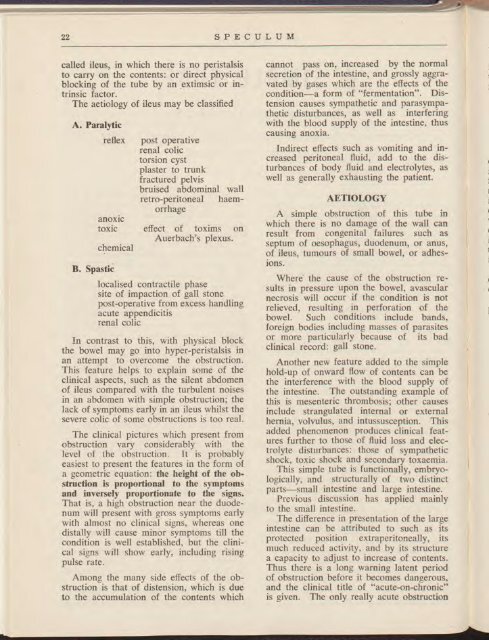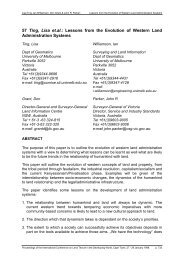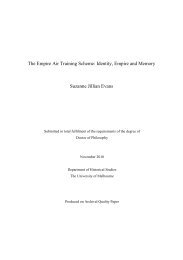Speculum - University of Melbourne
Speculum - University of Melbourne
Speculum - University of Melbourne
Create successful ePaper yourself
Turn your PDF publications into a flip-book with our unique Google optimized e-Paper software.
22 SPECULUM<br />
called ileus, in which there is no peristalsis<br />
to carry on the contents: or direct physical<br />
blocking <strong>of</strong> the tube by an extimsic or intrinsic<br />
factor.<br />
The aetiology <strong>of</strong> ileus may be classified<br />
A. Paralytic<br />
reflex<br />
anoxic<br />
toxic<br />
chemical<br />
post operative<br />
renal colic<br />
torsion cyst<br />
plaster to trunk<br />
fractured pelvis<br />
bruised abdominal wall<br />
retro-peritoneal haemorrhage<br />
effect <strong>of</strong> toxims on<br />
Auerbach's plexus.<br />
B. SpastiC<br />
localised contractile phase<br />
site <strong>of</strong> impaction <strong>of</strong> gall stone<br />
post-operative from excess handling<br />
acute appendicitis<br />
renal colic<br />
In contrast to this, with physical block<br />
the bowel may go into hyper-peristalsis in<br />
an attempt to overcome the obstruction.<br />
This feature helps to explain some <strong>of</strong> the<br />
clinical aspects, such as the silent abdomen<br />
<strong>of</strong> ileus compared with the turbulent noises<br />
in an abdomen with simple obstruction; the<br />
lack <strong>of</strong> symptoms early in an ileus whilst the<br />
severe colic <strong>of</strong> some obstructions is too real.<br />
The clinical pictures which present from<br />
obstruction vary considerably with the<br />
level <strong>of</strong> the obstruction. It is probably<br />
easiest to present the features in the form <strong>of</strong><br />
a geometric equation: the height <strong>of</strong> the obstruction<br />
is proportional to the symptoms<br />
and inversely proportionate to the signs.<br />
That is, a high obstruction near the duodenum<br />
will present with gross symptoms early<br />
with almost no clinical signs, whereas one<br />
distally will cause minor symptoms till the<br />
condition is well established, but the clinical<br />
signs will show early, including rising<br />
pulse rate.<br />
Among the many side effects <strong>of</strong> the obstruction<br />
is that <strong>of</strong> distension, which is due<br />
to the accumulation <strong>of</strong> the contents which<br />
cannot pass on, increased by the normal<br />
secretion <strong>of</strong> the intestine, and grossly aggravated<br />
by gases which are the effects <strong>of</strong> the<br />
condition—a form <strong>of</strong> "fermentation". Distension<br />
causes sympathetic and parasympathetic<br />
disturbances, as well as interfering<br />
with the blood supply <strong>of</strong> the intestine, thus<br />
causing anoxia.<br />
Indirect effects such as vomiting and increased<br />
peritoneal fluid, add to the disturbances<br />
<strong>of</strong> body fluid and electrolytes, as<br />
well as generally exhausting the patient.<br />
AETIOLOGY<br />
A simple obstruction <strong>of</strong> this tube in<br />
which there is no damage <strong>of</strong> the wall can<br />
result from congenital failures such as<br />
septum <strong>of</strong> oesophagus, duodenum, or anus,<br />
<strong>of</strong> ileus, tumours <strong>of</strong> small bowel, or adhesions.<br />
Where' the cause <strong>of</strong> the obstruction results<br />
in pressure upon the bowel, avascular<br />
necrosis will occur if the condition is not<br />
relieved, resulting in perforation <strong>of</strong> the<br />
bowel. Such conditions include bands,<br />
foreign bodies including masses <strong>of</strong> parasites<br />
or more particularly because <strong>of</strong> its bad<br />
clinical record: gall stone.<br />
Another new feature added to the simple<br />
hold-up <strong>of</strong> onward flow <strong>of</strong> contents can be<br />
the interference with the blood supply <strong>of</strong><br />
the intestine. The outstanding example <strong>of</strong><br />
this is mesenteric thrombosis; other causes<br />
include strangulated internal or external<br />
hernia, volvulus, and intussusception. This<br />
added phenomenon produces clinical features<br />
further to those <strong>of</strong> fluid loss and electrolyte<br />
disturbances: those <strong>of</strong> sympathetic<br />
shock, toxic shock and secondary toxaemia.<br />
This simple tube is functionally, embryologically,<br />
and structurally <strong>of</strong> two distinct<br />
parts—small intestine and large intestine.<br />
Previous discussion has applied mainly<br />
to the small intestine.<br />
The difference in presentation <strong>of</strong> the large<br />
intestine can be attributed to such as its<br />
protected position extraperitoneally, its<br />
much reduced activity, and by its structure<br />
a capacity to adjust to increase <strong>of</strong> contents.<br />
Thus there is a long warning latent period<br />
<strong>of</strong> obstruction before it becomes dangerous,<br />
and the clinical title <strong>of</strong> "acute-on-chronic"<br />
is given. The only really acute obstruction

















